Abstract
Anxiety-inducing life events increase the risk of motor vehicle crashes. We test the hypothesis that earthquakes, known to increase anxiety in the population, also increase the incidence of motor vehicle crashes. Our study took place in Oklahoma, USA where wastewater injection resulted in increased induced seismicity between 2010–2016. We identified dates of earthquakes ≥ magnitude 4 (a level felt by most people) with data from the U.S. Geologic Survey. The Oklahoma Highway Safety Office provided county-level monthly vehicle crash counts. We defined high, medium, and low earthquake exposure counties based on the location of earthquake epicenters. Using time-series analyses, we evaluated the association between monthly counts of ≥ magnitude 4 earthquakes and motor vehicle crashes by exposure group. Earthquakes ≥ magnitude 4 took place in 38 of 84 study months, and a monthly average of 5,813 (SD = 384) crashes occurred between 2010–2016. In high-exposure counties, we observed an additional 39.2 motor vehicle crashes per each additional ≥ magnitude 4 earthquake in the prior month (SE = 11.5). We found no association between the timing of ≥ magnitude 4 earthquakes and motor vehicle crashes in the medium or low exposure counties. With a binary earthquake exposure variable, we found a 4.6% (SE = 1.4%) increase in motor vehicle crashes in the high exposure counties in the month following 1 or more ≥ magnitude 4 earthquakes. Consistent with our hypothesis, there was no association between earthquakes of magnitude ≤ 2.5 and motor vehicle crashes in the high-exposure counties. This novel evidence of an association between induced earthquakes in Oklahoma and motor vehicle crashes warrants future research given the high economic and social costs of such vehicle crashes.
Keywords: Earthquakes, Anxiety, Motor Vehicles, Accidents, Traffic, Oklahoma, United States
Graphical abstract
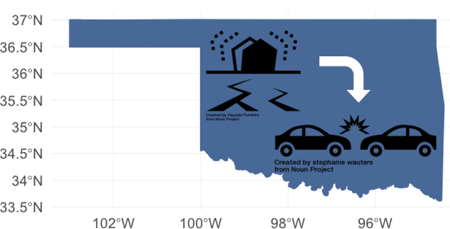
1. INTRODUCTION
Operators extract oil and gas using a range of methods that increasingly rely on horizontal drilling and hydraulic fracturing in shale formations, and fluid injection into wells to increase production. Much fluid returns to the surface and requires special disposal to avoid contamination of drinking or surface waters. Disposal alternatives include reinjection into class Ⅱ Underground Injection Control disposal wells. Reflecting the threat that such wastewater injection poses to human health and the environment, the U.S. Environmental Protection Agency (U.S. EPA) has authority to regulate reinjection.
In 2015, Oklahoma ranked 5th in overall energy production in the United States (1), and state disposal wells received over 400 billion liters of wastewater (2). Wastewater injection, particularly at high rates, has resulted in remarkably frequent induced earthquakes. For example, between 2010 and 2017, over 2,500 earthquakes exceeding moment magnitude-3 (i.e., M 3) occurred in Oklahoma (3, 4). When earthquakes reach a magnitude of 4, many people feel them, and while before 2010 no ≥ M 4 quakes were recorded in Oklahoma, 76 occurred between 2010–2016 (5).
The health implications of these earthquakes remain unclear. Past research, however, reports that earthquakes strong enough for human detection evoke psychological distress in populations experiencing them (6, 7). This implies that earthquakes induced by oil and gas production may induce distress and associated health outcomes. These potential health consequences may include trauma caused by motor vehicle crashes. Although vehicle crashes result from interactions between vehicles, roadways, and driver characteristics, human error (including distraction) reportedly accounts for approximately 93% of crashes (8–10). Further, acute psychological distress appears to increase the likelihood of traffic injuries (11). Anger, sadness, crying, emotional agitation, and behaviors like smoking or sending text messages may distract drivers from sensory inputs (9, 12).
In addition to acute effects on motor vehicle crashes, psychological distress resulting from earthquakes could also develop and influence individuals’ risk of crashes over a more prolonged period. Evidence-to-date supports the potential for earthquake exposure to have a delayed effect on the subsequent psychological response (13, 14). In a recent report, we found that Google search episodes for anxiety peaked 3 weeks after ≥ M 4 quakes in Oklahoma (15). Similarly, in Tsunan, Japan, earthquake-exposed versus unexposed individuals reported much higher prevalence of earthquake-related anxiety and insomnia two to four weeks after an M 6.7 earthquake (16).
In Figure 1, we show a conceptual framework illustrating how anxiety may link earthquakes to motor vehicle crashes. Anxiety caused by life stressors may lead, for example, to reduced sleep quality (17), distraction (18, 19), and dangerous driving behavior (18, 20), all of which can place drivers at risk of motor vehicle crashes (21, 22). In Oklahoma, for example, moderate earthquakes appear to reduce housing values and lead to longer time-on-market (23, 24). This type of financial strain may further increase individuals’ stress, distractibility, and irritability, thereby exacerbating risk of motor vehicle crashes (25).
Figure 1.
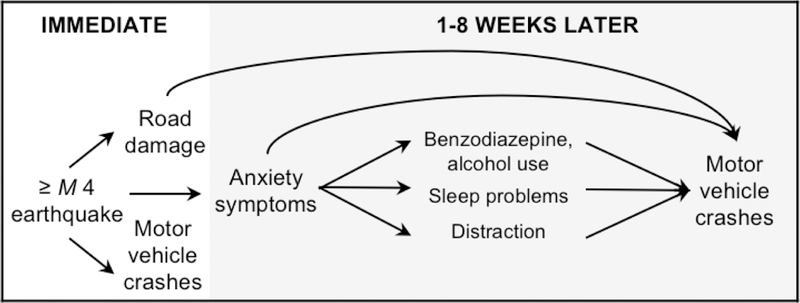
Conceptual framework illustrating potential pathways through which earthquakes ≥ moment magnitude (M) 4 could lead to increased motor vehicle crashes.
Here, we use time series methods to explore the relationship between monthly counts of earthquakes reported by the U.S. Geological Survey and motor vehicle crashes reported by the Oklahoma Highway Safety Office. Several circumstances motivated us to test this hypothesis including the economic and health burden vehicle crashes impose on society. Motor vehicle crashes cost Americans $242 billion nationwide and $2.9 billion in the state of Oklahoma in 2010 (26). We hypothesized that vehicle crashes would increase above otherwise expected levels in the month following ≥ M 4 quakes.
2. METHODS
2.1. Independent variable: earthquakes
We searched the publicly-available U.S. Geological Survey Advanced National Seismic System’s comprehensive earthquake catalog for Oklahoma earthquakes between 2010 and 2016 to obtain data on earthquake location, date, time, and magnitude. We defined our exposure of interest as the monthly count of earthquakes ≥ M 4 because Oklahoma residents likely would have felt earthquakes of this magnitude (5).
We divided the state of Oklahoma into three county groupings based on the epicenter of the of the ≥ M 4 earthquakes and to keep counties located within the same metropolitan area together: counties containing the majority of ≥ M 4 earthquakes and Oklahoma City metropolitan area (high exposure); counties bordering the high exposure counties and the Tulsa and Lawton metropolitan areas (medium exposure), and all other counties in the state (low exposure) (Figure 2).
Figure 2.
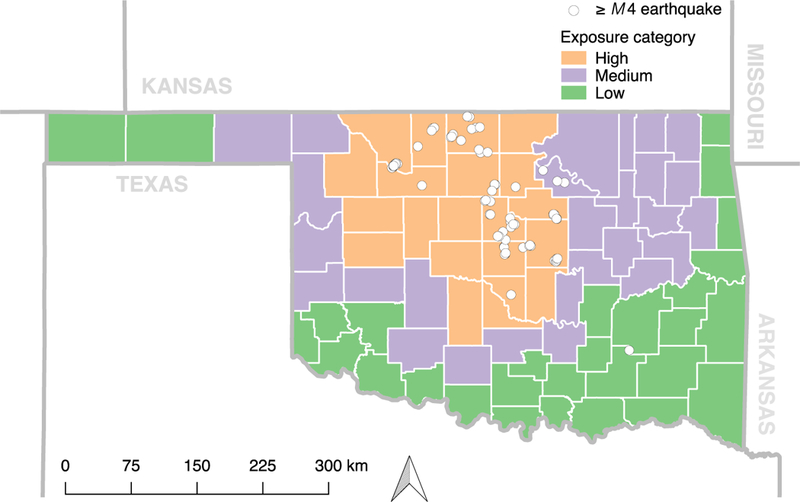
Distribution of ≥ moment magnitude (M) 4 earthquakes in Oklahoma between January 2010 to December 2016 by exposure group. Color designates the earthquake exposure group: tangerine, high exposure; purple, medium exposure; and green, low exposure. Data from the U.S. Geological Survey’s Advanced National Seismic System Comprehensive Earthquake Catalog (ComCat; https://earthquake.usgs.gov/earthquakes/search/).
We also characterized months by the number of earthquakes between local magnitude 1 and 2.5, a level captured by monitoring equipment, but not usually sensed by humans (5). As described below, we used the count of these less invasive quakes as a falsification test.
2.2. Dependent variable: motor vehicle crashes
The Oklahoma Highway Safety Office provided county-level data on the monthly number of motor vehicle crashes from 2010 through 2016 (Table A.1). We compiled the overall count of motor vehicle crashes each month and stratified by the county exposure groupings during the study period.
2.3. Statistical Analysis
Estimates of association typically measure the degree to which two variables differ from their statistically expected values in the same cases. Such estimates typically use the mean of all cases as the expected value under the assumption of independence. Variables measured over time often violate this assumption because they exhibit “autocorrelation” in the form of trends, cycles, and or the tendency to remain temporarily elevated or depressed after high or low values. The expected value of an autocorrelated variable is not its mean, but rather the value predicted by extrapolation from autocorrelation. Researchers since Fisher have modeled autocorrelation in variables and used the fitted values of the model as expected values and the model residuals (i.e., observed less fitted values) as a gauge of the degree to which observed values differ from expected. Wiener and Granger extended this logic to tests of causal relationships by arguing that the law of parsimony requires attributing autocorrelation to endogenous circumstances. Variation in Y predictable from the history of Y should not, in other words, be attributable to any exogenous X (27).
We applied Wiener-Granger logic in two steps. First, we used Box-Jenkins methods (28) to identify and specify autocorrelation in the monthly number of automobile crashes in Oklahoma for the 84 months beginning with January 2010 and ending with December 2016. Box-Jenkins methods identify which of an extensive set of models best describes serial measurements. The models essentially predict an observation at time t from observations at t-n. The models use the mathematical equivalent of long (i.e., autoregressive) and short (i.e., moving average) memory to describe autocorrelation efficiently. The residuals of a Box-Jenkins model exhibit no autocorrelation and have an expected value of “0” implying efficient estimation of the model coefficients and their confidence intervals.
Second, we estimated three test equations formed by expanding the Box-Jenkins equation identified in our first step to include a variable with counts of ≥ M 4 quakes (test model). We specified the earthquakes variable as occurring in the same month as the crashes as well as occurring in the preceding month (test model). The most general form of our test equation appears as follows:
Where Yt is the number of vehicle crashes in month t. µ is the mean of Y. ω1 and ω2 are estimated effect coefficients. Xt is the count of earthquakes ≥ M 4 occurring in the test area during month t. θBq is a moving average parameter for month t-p. ϕBp is an autoregressive parameter for month t-q. Seasonality, for example, in monthly vehicle crashes would imply autoregressive or moving average coefficients for which p or q would equal 12. at is the error term of the model at month t.
The above steps use Box-Jenkins methods to apply Wiener-Granger logic in that they remove from the dependent variable any cycles or trends induced, for example, by seasonal weather changes, population growth or decline, or the status of the economy. Any association discovered between crashes and M 4 earthquakes cannot arise from shared trends, seasonality, or regression to the mean after high or low values because the Box-Jenkins routines remove such autocorrelation. We performed data assembly and analyses using R 3.3.2 (R Core Team, Vienna, Austria) and Scientific Computing Associates Statistical System (Scientific Computing Associates, 2017).
3. RESULTS
Vital statistics reported 3.9 million Oklahoma residents lived across 181,035 km2 in 2016. The U.S. Geological Survey measured 8,462 earthquakes in the state from January 2010 through December 2016, with an average of 100 (SD = 112) per month. Of these, 76 equaled or exceeded magnitude 4.0 (i.e., M 4 earthquakes). The monthly number of M 4 earthquakes, shown in Figure 3, varied from 0–7 over the study period. For 51 out of 84 study months, no M 4 quakes occurred, for 18 months one ≥ M 4 quake occurred, and in the remaining 20 months, two or more took place.
Figure 3.
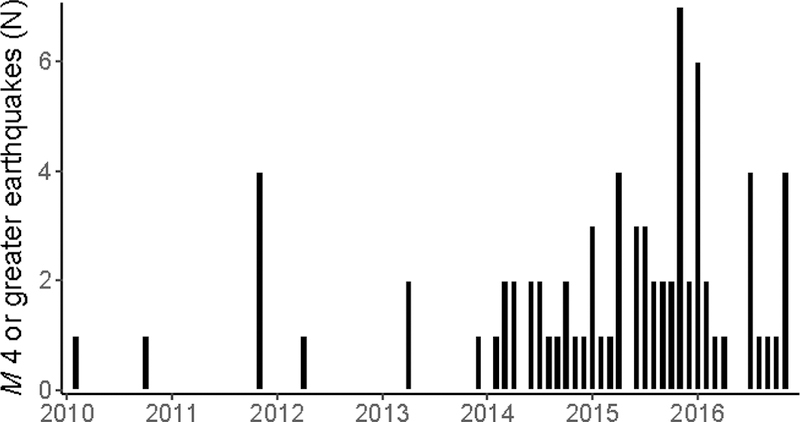
Number of Oklahoma earthquakes ≥ moment magnitude (M) 4 each month from January 2010 to December 2016. Data from the U.S. Geological Survey’s Advanced National Seismic System Comprehensive Earthquake Catalog (ComCat; https://earthquake.usgs.gov/earthquakes/search/).
Drivers in Oklahoma suffered a monthly average of 5,813 (SD = 384) crashes. In Table 1 we present the monthly means for high, medium, and low exposure groups are shown. Figure 4 and the panels in Figure 5 show the monthly incidence of crashes across the exposure groups and suggest a seasonal pattern. Since 2000, the variability in monthly crash counts has declined (Figure A.1). The panels in Figure 5 also show the number of crashes expected from the Box-Jenkins model identified in step 1 in our analyses.
Table 1.
Earthquakes and motor vehicle crashes by earthquake exposure group
| Exposure groupa | |||
|---|---|---|---|
| High | Medium | Low | |
| Number of counties | 21 | 27 | 29 |
| Number of M 4 earthquakes,b 2010–2016 |
72 | 4 | 0 |
| Monthly motor vehicle crashes, mean (SD) |
2915 (223) | 2222 (169) | 718 (56) |
Abbreviations: M, magnitude
Exposure based on location of ≥ M 4 earthquakes between 2010–2016.
A total of 76 earthquakes ≥ M 4 occurred between 2010–2016. The high exposure group covers the Oklahoma City metropolitan area, where 72 of the 76 ≥ M 4 earthquakes occurred; the medium exposure group covers the Tulsa and Lawton metropolitan areas, where 4 of the 76 ≥ M 4 earthquakes occurred. The low exposure group covers the Fort Smith metropolitan area where no ≥ M 4 earthquakes occurred.
Figure 4.
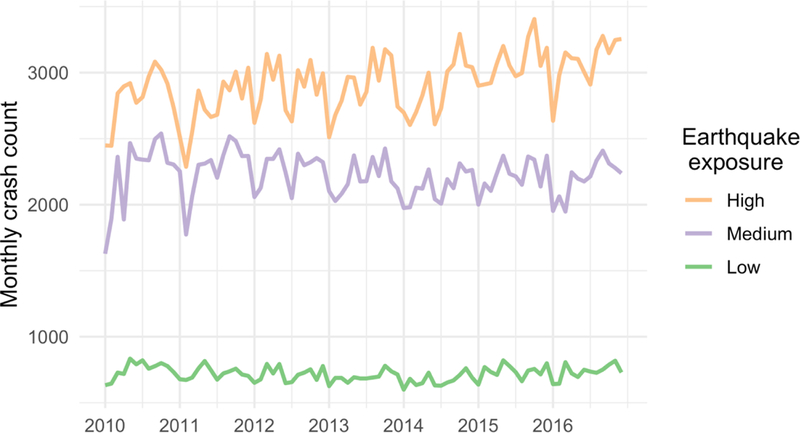
The number of Oklahoma motor vehicle crashes each month from January 2010 to December 2016 by exposure group. Color designates the earthquake exposure group: tangerine, high exposure; purple, medium exposure; and green, low exposure. Data provided by the Oklahoma Highway Safety Office (http://ohso.ok.gov/).
Figure 5.
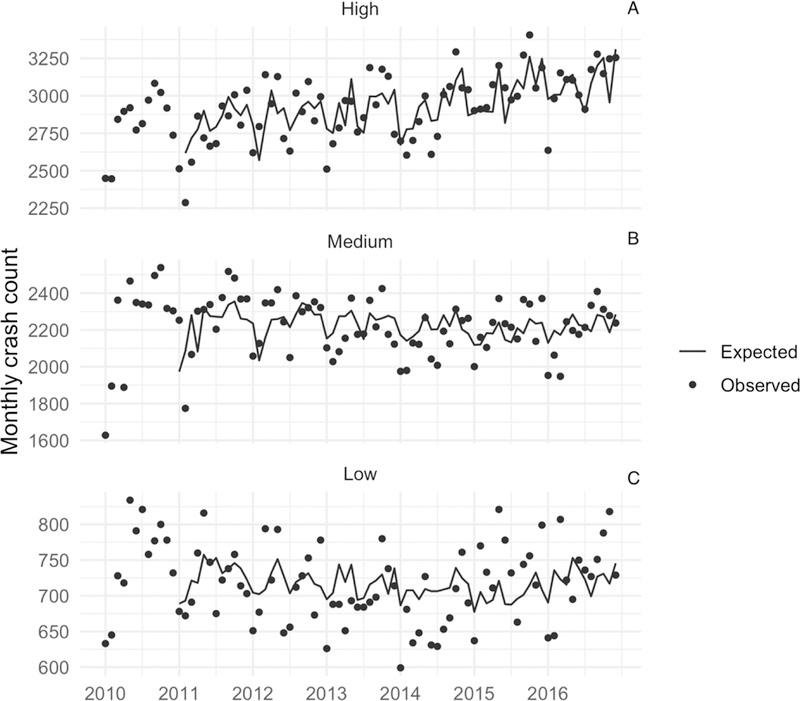
Number of observed and expected (from autocorrelation) Oklahoma motor vehicle crashes each month by earthquake exposure group from January 2010 to December 2016. A, high earthquake exposure; B, medium earthquake exposure; C, low earthquake exposure. Data provided by the Oklahoma Highway Safety Office.
As shown in Column 1 of Table 1, and consistent with our argument, motor vehicle crashes in the high exposure counties increased significantly (i.e., 39.3, SE = 11.5) with each ≥ M 4 quake in the previous month. As also shown in Table 1, we saw no significant associations between ≥ M 4 quakes and crashes for the medium and low exposure counties. Autoregression at 12 months for each exposure group indicates strong seasonality in motor vehicle crashes. In the high exposure counties, we saw significant autoregression at 1 month, implying that crashes at month t-1 predict those at t.
We conducted several additional tests of the association between motor vehicle crashes and ≥ M 4 quakes in the high exposure counties to estimate the robustness of our findings. First, we used routines devised by Chang, Taio, and Tien (27) to determine if outliers may have inflated our confidence intervals and led us to falsely accept the null for M 4 quakes in the same month as crashes. We detected no outliers.
Second, we estimated the test equation again but removed ≥ M 4 quakes in the same month as crashes. Results remained unchanged in that all the coefficients remained significantly different from 0 and the residuals exhibited no autocorrelation.
Third, we estimated the equation for the most exposed counties again but transformed the monthly counts of ≥ M 4 quakes into a binary variable scored “0” for months with no ≥ M 4 quakes and “1” for months with at least one. We also transformed crashes into their natural logarithms. These transformations allowed us to estimate the percent increase in crashes in the high exposure counties in the month following the occurrence of at least one ≥ M 4 quakes. We found that crashes increased, on average, by 4.6% (SE = 1.4%) (Table A.2).
Fourth, the fact that crashes in the low and medium exposure counties appeared unrelated to ≥ M 4 quakes suggested we could reasonably use them as “controls” for forces that may have influenced motor vehicle crashes statewide during the study period. We added the incidence of crashes in the low- and medium-affected counties as predictors to the test equation for high exposure counties and repeated the test. We found, consistent with our argument, that the coefficient for ≥ M 4 quakes in the month before crashes remained significantly greater than 0 (i.e., 34.2; SE = 12.5).
We also conducted two falsification tests for our results in the high exposure counties. First, we repeated our test but used the monthly count of earthquakes < 2.5 in local magnitude (Figure A.2). These quakes do not release sufficient energy for most persons to detect them. We, therefore, would expect and observed no significant association between these smaller quakes and motor vehicle crashes (Table A.3). Second, we added ≥ M 4 quakes two months earlier than crashes to our original test equation. We have no a priori hypothesis for such a “lagged” association. None appeared (results not shown).
4. DISCUSSION
We report a novel association between induced earthquakes of magnitude ≥ 4 in one month and motor vehicle crashes during the following month in the counties most exposed to the earthquakes in Oklahoma from 2010 through 2016. In the months following one or more ≥ M 4 earthquakes, on average, motor vehicle crashes increased by 4.6% in high exposure counties. We observed no such relationship in medium and low earthquake exposure counties.
As noted above, the Granger-Wiener approach we applied to our test controls for shared autocorrelation that could otherwise induce false rejection of the null hypothesis. Trends caused by population growth or migration, for example, cannot explain our results. To spuriously induce our results, drivers in significant numbers would have to migrate into the high exposure counties in Oklahoma in months after 1 or more M 4 quakes occur but then migrate out the next month.
Immediate changes to the driving environment may link the most severe earthquakes and vehicle crashes (29). For example, the 2011 earthquake centered in Prague, Oklahoma was sufficiently forceful (M 5.7) to buckle pavement (4). In the immediate aftermath, this roadway damage could increase motor vehicle crashes or reduce vehicle miles traveled (30), thereby reducing overall crash counts. We did not find an association between earthquakes and crashes in the same month; instead, we observed an association between earthquakes in one month and motor vehicle crashes in the following month, suggesting the latter mechanism. Further, the majority of observed earthquakes ranged in magnitude from M 4 to M 4.9, a magnitude felt by most individuals, but not sufficient to yield immediate structural damage to roadways. Therefore, we posit psychological distress as the primary mechanism by which the Oklahoma earthquakes may influence motor vehicle crashes. Future studies should further investigate the latency period between experience of an earthquake, psychological response, and motor vehicle crashes.
Psychological response to earthquakes may vary. Past research reports that moderate (M 5.6 and M 5.9) earthquakes evoke psychological distress in populations experiencing them (6, 7). In Oklahoma, home prices appear to drop after earthquake exposure (23) and a recent study from the Netherlands found individuals who had experienced multiple induced earthquakes or associated home damage reported distress related to perceived safety (31). Moreover, before 2010 Oklahoma had recorded no earthquakes ≥ M 4 (32), earthquakes generally occur without warning, and individuals live with the possibility of repeated aftershocks; the unpredictability of these stressors may be a considerable source of psychiatric distress. Because earthquakes in Oklahoma are directly attributable to human activity (33), they may engender especially negative feelings of anger and frustration (34).
Sleep and substance-use disorders may also represent a meaningful component of the earthquake-related psychological response. Repeated exposure to induced earthquakes may lead to sleep problems, anxiety-related prescriptions (e.g., benzodiazepines), and coping mechanisms including drug and alcohol use. Anxiety and insomnia often co-occur (35), and hyperarousal from an acute stressor (e.g., earthquake) may lead to sleep problems (36). Acute exposures may likewise increase both anxiety and alcohol use (37). These conditions and activities may increase subsequent risk of motor vehicle crashes. Driver sleepiness appears to cause 1–3% of U.S. motor vehicle crashes (17), and prescription sedatives and alcohol may further potentiate the effect of sleepiness on crashes (38). In 2015, Oklahoma suffered 669 fatalities in vehicle collisions, and 170 (25%) involved a driver having a blood alcohol level of 0.08 or more (39).
Readers should interpret the observed association between induced earthquakes and subsequent vehicle crashes in the most exposed counties cautiously given the ecological nature of our test. We cannot know, for example, if the Oklahoma drivers involved in crashes in month t felt an earthquake in month t-1. While the intensity of exposure to earthquakes may correlate with response, other factors including personality and history of psychiatric disorder also play a role (40). The association we report may have arisen not from earthquake effects on driver behavior, but from earthquake effects on some other crash-inducing phenomenon that we have not anticipated. Nor can we rule out that some crash-inducing factor unrelated to earthquakes occurred by chance in the months following those with an M 4 or greater earthquake. We can think of no such factor. Further, when we include crash counts from the medium and low exposure counties in the test for the high exposure counties we continue to observe a significant relationship between ≥ M 4 earthquakes and motor vehicle crashes. Null results from a falsification test that used earthquakes of < M 2.5 in the month before motor vehicle crashes as the exposure also supports our main finding.
5. CONCLUSIONS
We provide preliminary results related to the hypothesis that injection-induced earthquakes in Oklahoma may increase motor vehicle crashes in the following month. This topic warrants further research due to the high economic and social costs–$242 billion nationwide and $2.9 billion in Oklahoma in 2010 (26)–of motor vehicle crashes. Our ecologic study included data with limited temporal and spatial resolution. Future research should gather data on driver characteristics that would allow identifying which, if any, subgroups appear most at risk of crashes following earthquakes (12). Individual-level analysis could also more precisely link earthquake exposures to study participants. Additional research should also strive for greater temporal resolution. The data available to us allowed tests only the monthly level. Daily or weekly data would allow more informative exposure-response estimates. Finally, future work should explore cumulative and habituation effects to determine if repeated exposure to earthquakes increases or decreases dose response.
Supplementary Material
Table 2.
Estimated coefficients for models predicting motor vehicle crashes in Oklahoma counties from earthquakes of magnitude (M) 4 and autocorrelation from January 2010 through December 2016 (n = 84 months).
| Exposure groupa | |||
|---|---|---|---|
| High | Medium | Low | |
| Coefficient (SE) | Coefficient (SE) | Coefficient (SE) | |
| Mean monthly crashes | 2915 (24) | 2222 (18) | 718 (6) |
| ≥ M 4 earthquake month t | −15.9 (11.9) | −10.8 (9.4) | −2.5 (3.8) |
| ≥ M 4 earthquake month t-1 | 39.2 (11.5) | 8.1 (9.3) | 3.2 (3.7) |
| Autoregression at 1 | 0.40 (0.11) | None | None |
| Autoregression at 12 | 0.48 (0.10) | 0.40 (0.09) | 0.33 (0.11) |
Abbreviations: M, magnitude; SE, standard error
A total of 76 earthquakes ≥ M 4 occurred between 2010–2016. The high exposure group covers the Oklahoma City metropolitan area, where 72 of the 76 ≥ M 4 earthquakes occurred; the medium exposure group covers the Tulsa and Lawton metropolitan areas, where 4 of the 76 ≥ M 4 earthquakes occurred. The low exposure group covers the Fort Smith metropolitan area where no ≥ M 4 earthquakes occurred.
HIGHLIGHTS.
Oklahoma had 76 earthquakes ≥ magnitude 4 between 2010–2016
Motor vehicle crashes may result from stress, anxiety, and distraction
An average of 5,813 crashes took place monthly in Oklahoma between 2010–2016
More crashes occurred than expected following months with ≥ magnitude 4 earthquakes
These results were limited to the counties most exposed to the earthquakes
Acknowledgements:
This project was funded, in part, through a National Institute of Environmental Health Sciences grant K99ES027023 to J.A.C. We thank data analysts at the Oklahoma Highway Safety Office for assistance in preparing the motor vehicle crash data.
Footnotes
Publisher's Disclaimer: This is a PDF file of an unedited manuscript that has been accepted for publication. As a service to our customers we are providing this early version of the manuscript. The manuscript will undergo copyediting, typesetting, and review of the resulting proof before it is published in its final citable form. Please note that during the production process errors may be discovered which could affect the content, and all legal disclaimers that apply to the journal pertain.
Conflicts of interest: The authors declare that they have no conflict of interest.
REFERENCES
- 1.U.S. Energy Information Agency. Oklahoma State Profile and Energy Estimates 2018. https://www.eia.gov/state/?sid=OK#tabs-3 (26 February 2018, date last accessed).
- 2.Auch T Oklahoma and Kansas Class II Injection Wells and Earthquakes 2016. https://www.fractracker.org/2016/12/oklahoma-kansas-injection-wells/ (13 March 2018, date last accessed).
- 3.Weingarten M, Ge S, Godt JW, Bekins BA, Rubinstein JL. Induced Seismicity. High-rate injection is associated with the increase in U.S. mid-continent seismicity. Science 2015;348(6241):1336–40. [DOI] [PubMed] [Google Scholar]
- 4.Keranen KM, Savage HM, Abers GA, Cochran ES. Potentially induced earthquakes in Oklahoma, USA: Links between wastewater injection and the 2011 Mw 5.7 earthquake sequence. Geology 2013;41(6):699–702. [Google Scholar]
- 5.United States Geological Survey. Magnitude/Intensity Comparison 2017. https://earthquake.usgs.gov/learn/topics/mag_vs_int.php (05 June 2017, date last accessed).
- 6.Carr VJ, Lewin TJ, Webster RA, Kenardy JA, Hazell PL, Carter GL. Psychosocial sequelae of the 1989 Newcastle earthquake: II. Exposure and morbidity profiles during the first 2 years post-disaster. Psychol Med 1997;27(1):167–78. [DOI] [PubMed] [Google Scholar]
- 7.Livanou M, Kasvikis Y, Basoglu M, Mytskidou P, Sotiropoulou V, Spanea E, et al. Earthquake-related psychological distress and associated factors 4 years after the Parnitha earthquake in Greece. Eur Psychiatry 2005;20(2):137–44. [DOI] [PubMed] [Google Scholar]
- 8.Roshandel S, Zheng Z, Washington S. Impact of real-time traffic characteristics on freeway crash occurrence: systematic review and meta-analysis. Accid Anal Prev 2015;79:198– 211 [DOI] [PubMed] [Google Scholar]
- 9.Dingus TA, Guo F, Lee S, Antin JF, Perez M, Buchanan-King M, et al. Driver crash risk factors and prevalence evaluation using naturalistic driving data. Proc Natl Acad Sci U S A 2016;113(10):2636–41. [DOI] [PMC free article] [PubMed] [Google Scholar]
- 10.National Highway Traffic Safety Administration. Strategy for Vehicle Safety Strategic Planning for Domestic and Global Integration of Vehicle Safety 2013.
- 11.Petridou E, Moustaki M. Human factors in the causation of road traffic crashes. Eur J Epidemiol 2000;16(9):819–26. [DOI] [PubMed] [Google Scholar]
- 12.Klauer SG, Guo F, Simons-Morton BG, Ouimet MC, Lee SE, Dingus TA. Distracted driving and risk of road crashes among novice and experienced drivers. N Engl J Med 2014;370(1):54–9. [DOI] [PMC free article] [PubMed] [Google Scholar]
- 13.Kendler KS, Karkowski LM, Prescott CA. Stressful life events and major depression: risk period, long-term contextual threat, and diagnostic specificity. J Nerv Ment Dis 1998;186(11):661–9. [DOI] [PubMed] [Google Scholar]
- 14.Wainwright NW, Surtees PG. Time-varying exposure and the impact of stressful life events on onset of affective disorder. Stat Med 2002;21(14):2077–91. [DOI] [PubMed] [Google Scholar]
- 15.Casey JA, Goldman-Mellor S, Catalano R. Association between Oklahoma earthquakes and anxiety-related Google search episodes. Environ Epi 2018;2(e016). [DOI] [PMC free article] [PubMed] [Google Scholar]
- 16.Shindo M, Kitamura H, Tachibana A, Honma H, Someya T. Early psychological distress among sufferers after the 2011 Northern Nagano Prefecture Earthquake. Psychiatry Clin Neurosci 2012;66(5):454–6. [DOI] [PubMed] [Google Scholar]
- 17.Lyznicki JM, Doege TC, Davis RM, Williams MA, for the Council on Scientific A, American Medical A. Sleepiness, driving, and motor vehicle crashes. JAMA 1998;279(23):1908–13. [DOI] [PubMed] [Google Scholar]
- 18.Dula CS, Adams CL, Miesner MT, Leonard RL. Examining relationships between anxiety and dangerous driving. Accid Anal Prev 2010;42(6):2050–6. [DOI] [PubMed] [Google Scholar]
- 19.Fairclough SH, Tattersall AJ, Houston K. Anxiety and performance in the British driving test. Transp Res Part F Traffic Psychol Behav 2006;9(1):43–52. [Google Scholar]
- 20.Shahar A Self-reported driving behaviors as a function of trait anxiety. Accident Anal Prev 2009;41(2):241–5. [DOI] [PubMed] [Google Scholar]
- 21.Rowden P, Matthews G, Watson B, Biggs H. The relative impact of work-related stress, life stress and driving environment stress on driving outcomes. Accid Anal Prev 2011;43(4):1332–40. [DOI] [PubMed] [Google Scholar]
- 22.Selzer ML, Vinokur A. Life events, subjective stress, and traffic accidents. Am J Psychiatry 1974;131(8):903–6. [DOI] [PubMed] [Google Scholar]
- 23.Cheung R, Wetherell D, Whitaker S. Induced earthquakes and housing markets: Evidence from Oklahoma. Reg Sci Urban Econ 2018;69:153–66. [Google Scholar]
- 24.Metz NE, Roach T, Williams JA. The costs of induced seismicity: A hedonic analysis. Econ Lett 2017;160:86–90. [Google Scholar]
- 25.Norris FH, Matthews BA, Riad JK. Characterological, situational, and behavioral risk factors for motor vehicle accidents: a prospective examination. Accid Anal Prev 2000;32(4):505–15. [DOI] [PubMed] [Google Scholar]
- 26.Administration NHTS. The economic and societal impact of motor vehicle crashes, 2010. Report DOT HS 2014;812:013. [Google Scholar]
- 27.Bressler SL, Seth AK. Wiener-Granger causality: a well established methodology. Neuroimage 2011;58(2):323–9. [DOI] [PubMed] [Google Scholar]
- 28.Box G, Jenkins G, Reinsel G. Time Series Analysis: Forecasting and Control 4th ed. Hoboken, NJ: Wiley; 2008. [Google Scholar]
- 29.Haddon W Advances in the epidemiology of injuries as a basis for public policy. Public Health Rep 1980;95(5):411–21. [PMC free article] [PubMed] [Google Scholar]
- 30.Giuliano G, Golob J. Impacts of the Northridge earthquake on transit and highway use. J Transport Stat 1998;1(2):1–20. [Google Scholar]
- 31.Perlaviciute G, Steg L, Hoekstra EJ, Vrieling L. Perceived risks, emotions, and policy preferences: A longitudinal survey among the local population on gas quakes in the Netherlands. Energy Res Soc Sci 2017;29:1–11. [Google Scholar]
- 32.Keranen KM, Weingarten M. Induced Seismicity. Annu Rev Earth Planet Sci 2018(0). [Google Scholar]
- 33.Katz R, Wykes T. The psychological difference between temporally predictable and unpredictable stressful events: Evidence for information control theories. J Pers Soc Psychol 1985;48(3):781–90. [Google Scholar]
- 34.McComas KA, Lu H, Keranen KM, Furtney MA, Song H. Public perceptions and acceptance of induced earthquakes related to energy development. Energ Policy 2016;99:27–32. [Google Scholar]
- 35.Riemann D Insomnia and comorbid psychiatric disorders. Sleep Med 2007;8 Suppl 4:S15–20. [DOI] [PubMed] [Google Scholar]
- 36.Riemann D, Spiegelhalder K, Feige B, Voderholzer U, Berger M, Perlis M, et al. The hyperarousal model of insomnia: a review of the concept and its evidence. Sleep Med Rev 2010;14(1):19–31. [DOI] [PubMed] [Google Scholar]
- 37.Kushner MG, Abrams K, Borchardt C. The relationship between anxiety disorders and alcohol use disorders: A review of major perspectives and findings. Clin Psychol Rev 2000;20(2):149–71. [DOI] [PubMed] [Google Scholar]
- 38.Hansen RN, Boudreau DM, Ebel BE, Grossman DC, Sullivan SD. Sedative Hypnotic Medication Use and the Risk of Motor Vehicle Crash. Am J Public Health 2015;105(8):e64–e9. [DOI] [PMC free article] [PubMed] [Google Scholar]
- 39.Thomson M 2016. Annual Report Oklahoma Highway Safety Office Oklahoma City, OK; 2016. [Google Scholar]
- 40.McFarlane AC. The aetiology of post-traumatic stress disorders following a natural disaster. Br J Psychiatry 1988;152:116–21. [DOI] [PubMed] [Google Scholar]
Associated Data
This section collects any data citations, data availability statements, or supplementary materials included in this article.


